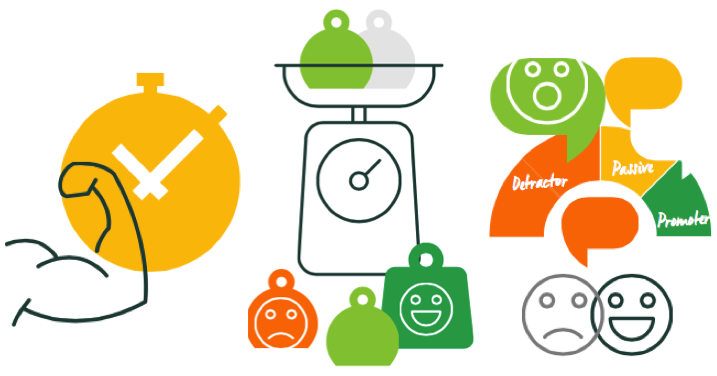The 3 Most Widely Used CX Metrics

In this post we provide a brief outline of the three most widely used CX metrics. While these metrics will be recognisable to people who work in the CX arena, oftentimes people who are not working within the space will not be as familiar.
At the bottom there is a link where you can download a convenient infographic that can be shared with relevant stakeholders to make it easier to communicate the available metrics that can be used to measure customer experience.
As always, we are open to feedback, so please feel free to add a comment at the bottom.
Customer Satisfaction (CSAT):
The most straightforward CX measurement is the CSAT score. According to Gartner, 70% of companies report customer satisfaction scores to executives. A CSAT score can be generated from simply asking customers to rate their experience.
With a CSAT question, you ask your customer:
On a scale of 1-10 how happy were you with your experience?
CSAT is probably the most versatile and customizable of the bunch. It makes it easy to ask your customers questions at different intervals along the customer lifecycle and identify areas in which your service needs to improve based on individual experiences.

While CSAT measures the short-term satisfaction of a customer’s experience, a Net Promoter Score (NPS) measures you customer’s overall sentiment and loyalty regarding your company.
On a scale of 0-10, how likely are you to recommend [Company Name] to a friend or colleague?
Respondents can be grouped into three categories:
(10-9) Promoters: enthusiastic customers who will fuel growth;
(8-7) Passives: satisfied, yet unenthusiastic customers who may opt for competitors in the future;
(6-0) Detractors: unhappy customers who can impede growth and damage your reputation.
Businesses often turn to NPS as a KPI and the score is often used to motivate an organization to become more focused on improving products and services for consumers. It is probably the metric that we see most businesses focusing on, and for this reason, it can be useful when it comes to market benchmarking.
Customer Effort Score (CES):

A Customer Effort Score (CES) is a measurement based on ease of experience. We have seen an increase in the popularity of this measurement. Rather than asking customers about the quality of their experiences, a CES survey will ask customers to gauge the ease of their experience with your company. Customers don’t seek to be “dazzled” at every interaction with a company. To keep them coming back, they want ease and efficiency.
The scale for CES can be counter-intuitive, as when it was designed, a low score equated to effort, but with other metrics, a low score usually means a poor experience:
On a scale of 1-5 where 5 is easiest, how much effort did you have to put forth to handle your request?
But you can easily change the way the question is framed, here is one example
Do you agree or disagree with the following? [Company Name] made it easy for me to handle my issue.
The idea is that if a customer had an easy experience, they are more likely to be loyal to your company.
Conclusion:
None of these metrics are perfect and each comes with its fair share of critics. Each measurement serves a particular purpose and they should not be looked at in isolation. To get the most out of your metrics, you should bolster your CX research with additional qualitative analysis. and always integrate your data for extra contextual insight. Customer experience metrics don’t need to be complicated and gaining a technical understanding of your customers’ sentiments and experiences can only make your business better. Aggregating customer feedback will help you to pinpoint what your business is doing right and where there is room for improvement.
Click below to download our CX metrics infographic.


